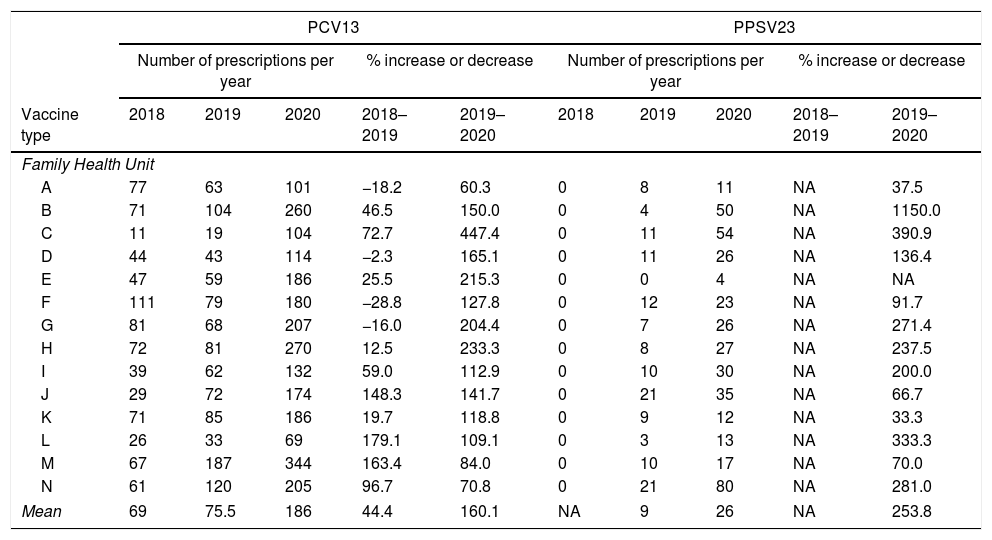Patients’ fears and health-seeking behaviours along with physicians’ insight into diseases, change during pandemics.1 With COVID-19, the authors noticed an increased interest in disease-preventable vaccines such as pneumococcal vaccination. On this premise, a question arises whether an airborne virus pandemic may increase the prescription of this vaccine.
A cross-sectional study was developed to describe the variation of pneumococcal vaccination prescription in adult patients (age over 18 years), between 2018 and 2020, in the Gondomar Health Centre Group, Portugal. Pneumococcal vaccination was assessed through the prescription of Pneumococcal Conjugate Vaccine (PCV13) and Pneumococcal Polysaccharide Vaccine (PPSV23) in the public health service. Data was collected May 18th 2021 from the public database “Bilhete de Identidade dos Cuidados de Saúde Primários” concerning the 14 family health units (FHU). Since this study only involved data freely available in the public domain and no individual-level data was accessed, it did not require ethical approval.
Of the 14 FHU studied, all of them have seen an increase in the PCV13 and PPSV23 prescription. Compared to 2019, the mean percentage increase to 2020 was 160.1% for PCV13 and 253.8% for PPSV23 (Table 1).
Vaccination prescription in adult patients (age over 18 years) with PCV13 and PPSV23 vaccines, prescribed in 2018, 2019 and 2020 in the studied Family Health Units (n=14).
| PCV13 | PPSV23 | |||||||||
|---|---|---|---|---|---|---|---|---|---|---|
| Number of prescriptions per year | % increase or decrease | Number of prescriptions per year | % increase or decrease | |||||||
| Vaccine type | 2018 | 2019 | 2020 | 2018–2019 | 2019–2020 | 2018 | 2019 | 2020 | 2018–2019 | 2019–2020 |
| Family Health Unit | ||||||||||
| A | 77 | 63 | 101 | −18.2 | 60.3 | 0 | 8 | 11 | NA | 37.5 |
| B | 71 | 104 | 260 | 46.5 | 150.0 | 0 | 4 | 50 | NA | 1150.0 |
| C | 11 | 19 | 104 | 72.7 | 447.4 | 0 | 11 | 54 | NA | 390.9 |
| D | 44 | 43 | 114 | −2.3 | 165.1 | 0 | 11 | 26 | NA | 136.4 |
| E | 47 | 59 | 186 | 25.5 | 215.3 | 0 | 0 | 4 | NA | NA |
| F | 111 | 79 | 180 | −28.8 | 127.8 | 0 | 12 | 23 | NA | 91.7 |
| G | 81 | 68 | 207 | −16.0 | 204.4 | 0 | 7 | 26 | NA | 271.4 |
| H | 72 | 81 | 270 | 12.5 | 233.3 | 0 | 8 | 27 | NA | 237.5 |
| I | 39 | 62 | 132 | 59.0 | 112.9 | 0 | 10 | 30 | NA | 200.0 |
| J | 29 | 72 | 174 | 148.3 | 141.7 | 0 | 21 | 35 | NA | 66.7 |
| K | 71 | 85 | 186 | 19.7 | 118.8 | 0 | 9 | 12 | NA | 33.3 |
| L | 26 | 33 | 69 | 179.1 | 109.1 | 0 | 3 | 13 | NA | 333.3 |
| M | 67 | 187 | 344 | 163.4 | 84.0 | 0 | 10 | 17 | NA | 70.0 |
| N | 61 | 120 | 205 | 96.7 | 70.8 | 0 | 21 | 80 | NA | 281.0 |
| Mean | 69 | 75.5 | 186 | 44.4 | 160.1 | NA | 9 | 26 | NA | 253.8 |
A study that evaluated worldwide interest in vaccination from 2015 to 2020 found a significant correlation between the COVID-19 pandemic period and interest in influenza and pneumococcal vaccines.1 Paguio et al. considered three plausible explanations – increase in population health-seeking behaviour, the CDC recommendation for annual influenza vaccination, or a change in perception about vaccine-preventable diseases.1 Another cross-sectional study of another Health Centre Group in Portugal, assessed the variation of flu vaccine coverage in patients with diabetes, chronic respiratory disease, chronic heart disease or age over 65 between 2018 and 2020.2 Prazeres and Passos came to similar results, pointing that the awareness of the general public regarding contagious respiratory diseases and the campaign of COVID-19 vaccination might increase confidence in the safety of vaccines. Although pneumococcal disease is not caused by an airborne virus, our results agree with the studies described above, suggesting an increasing concern of patients and physicians regarding infectious respiratory diseases.
On the other hand, the EPICOVID19 survey3 suggests that pneumococcal and, to a lesser extent, influenza vaccinations may be associated with a lower probability of SARS-CoV-2 infection. Lewnard, J.A. et al, within a cohort of adults over 65 years, conclude that PCV13 immunization was associated with lower incidence of COVID-19 diagnosis, hospitalization, and fatal COVID-19 hospitalization after correction for multiple potential sources of confounding.4
Even though we acknowledge that prescription does not always mean inoculation, these findings show an increased awareness of pneumococcal vaccination among family physicians. It also raised our perception of the possible impact of pneumococcal vaccination in the outcomes of COVID-19 patients and praised the importance of primary prevention. The COVID-19 pandemic has challenged health systems worldwide with severe consequences on global morbimortality. The possibility of reducing the impact of respiratory disease sequelae in a primary and secondary prevention perspective during the post-pandemic period should always be considered by family physicians.







